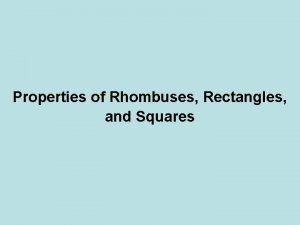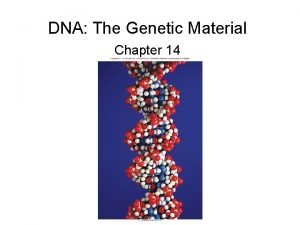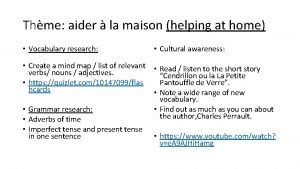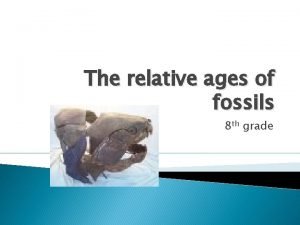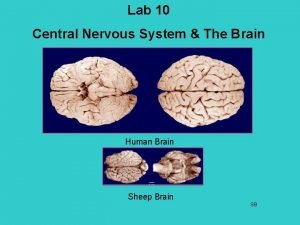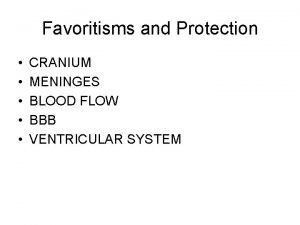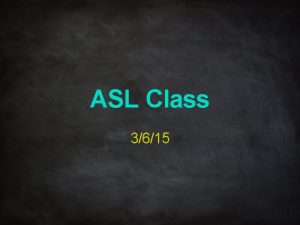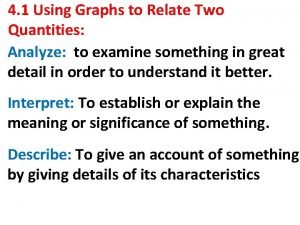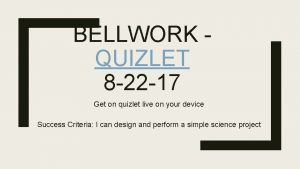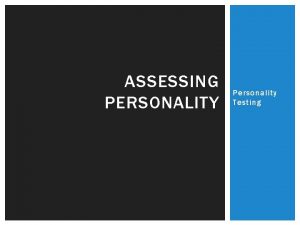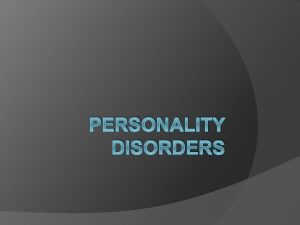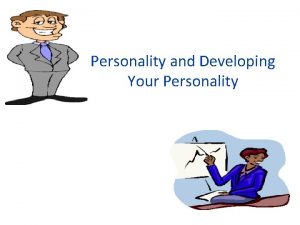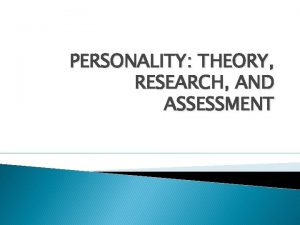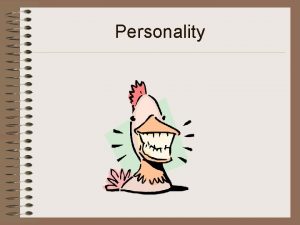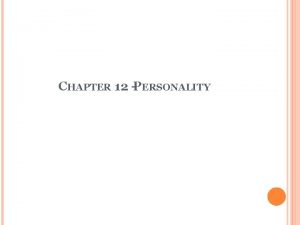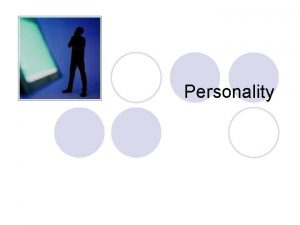Testing and Personality Resources http quizlet com252200appsychology personalityflashcards














































- Slides: 46

Testing and Personality

Resources http: //quizlet. com/252200/ap-psychology- personality-flash-cards/ http: //quizlet. com/9218190/myers-appsychology-unit-11 -testing-and-individualdifferences-flash-cards/

Standardization and Norms Standardized- the test items have been piloted on a similar population of people who are meant to take the test and achievement norms have been established Use of standardization samples

Reliability The consistency of the test as a means of measurement Split-half reliability- randomly dividing a test into two different sections and then correlating performance on the two halves Equivalent form reliability- correlation between performance on different forms of the test Test-retest reliability- the correlation of a person’s score taking the test two different times

Validity The test measures what it is supposed to measure The accuracy of the test Content validity- how well a measure reflects the entire range of material it is supposed to be testing Predictive validity- a measure of future performance Construct validity- how highly something correlates with another measure already in place ▪ Thought to be the most meaningful kind of validity

Types of Tests Aptitude Tests Measure ability or potential (SAT) Achievement Test Measure what one has learned or accomplished (APs) Speed Test Lots of questions in a short amount of time Power test Gauge the difficulty of problems that one can solve

Intelligence Intelligence- the ability to gather and use information in productive ways Fluid intelligence- our ability to solve abstract problems and pick up new info/skills Seems to decrease with age Crystallized Intelligence- involves using knowledge accumulated over time Seems to hold steady with time

Theories of Intelligence Charles Spearman • one intelligence • g” (general intelligence) Howard Gardner • multiple intelligences • linguistic • logicalmathematical, • spatial • musical • bodilykinesthetic • intrapersonal, • interpersonal • naturalistic Daniel Golman • EQ • emotional intelligence Robert Sternberg • Triarchic Theory • Analytic, Creative, Practical

Intelligence Testing The Stanford-Binet Alfred Binet- came up with the idea of mental age Created by Louis Terman: IQ = mental age/ chronological age Assigned all adults the arbitrary age of 20 WAIS (adults) and WISC (children 6 -26) David Weshcler Standardized so that the mean is 100 and the SD is 15 Also a WPPSI (preschoolers) 11 subscales combined to create a verbal and performance score- can find learning disabilities

Intelligence Testing

Bias in Testing Researchers seem to agree that although different races and sexes may score differently, they have the same predictive validity for all groups on IQ and SAT tests Advantages seen to accrue to the white, middle and upper classes

Nature vs. Nurture Heritability- measure of how much of a trait’s variation can be credited to genetic factors in a population, ranges from 0 to 1 Flynn effect- performance on intelligence tests has been steadily increasing throughout the century Monozygotic twins perform more similarly on intelligence tests than dizygotic twins

Personality The unique attitudes, behaviors, and emotions that categorize a person Schools of Thought Psychodynamic Trait Biological Behaviorist Social. Cognitive Humanistic

Freudian Theory- Stages of Development Oral Stage (0 -1) • Pleasure from sucking and biting Anal Stage (1 -3) • Pleasure from elimination Phallic Stage (3 -5) • Pleasure from the genitals • Oedipus Complex- boys sexually desire their mothers and view their fathers as rivals • Girls evidence penis envy; boys suffer from castration anxiety • Boys must learn to identify with their fathers Latency Stage (6 puberty) Genital Stage (puberty onward) • Repress sexual feelings so that they can turn their attention to other issues • Stay in this stage for the rest of one’s life

Freudian Theory- Stages of Development Fixations can develop from being either over or undergratified Oral fixations Anal expulsive (messy) Anal retentive (neat and hyperorganized) Sexual issues (libido is stuck in the phallic stage)

The Unconscious According to Freud- a reservoir of mostly unacceptable thoughts, wishes, feelings and memories Contemporary viewpoint- information processing of which we are unaware Preconscious information that is not conscious, but is retrievable into conscious awareness

Three Parts of Personality Ego Conscious mind Unconscious mind Superego Id

Three Parts of Personality Id Ego Superego • reservoir of unconscious psychic energy • strives to satisfy basic sexual and aggressive drives • operates on the pleasure principle, demanding immediate gratification • Includes eros (life instincts) and thantos (death instincts) • the largely conscious, “executive” part of personality • mediates among the demands of the id, superego and reality • operates on the reality principle, satisfying the id’s desires in ways that will realistically bring pleasure rather than pain • the part of personality that presents internalized ideals • provides standards for judgement and for future aspirations

Defense Mechanisms The ego’s protective methods of distorting reality Repression Denial Displacement Projection • Blocking thoughts from conscious awareness • Not accepting the ego threatening truth • Redirecting • Believing the one’s feelings one has toward another toward person or object someone else are actually held by another person directed at oneself

Defense Mechanisms The ego’s protective methods of distorting reality Reaction formation • Expressing the opposite of how one truly feels Regression Rationalization Intellectualization Sublimation • Channeling • Returning to an frustration earlier, • Coming up with • Undertaking an towards a comforting a beneficial academic, different goal form of response of an unemotional behavior undesirable study of the occurrence topic

Criticisms of Freud Very little empirical (scientific) that supports it Has little predictive power Overestimates the importance of early childhood and of sex Feminists object Karen Horney and Nancy Chodrow ▪ Freud assumed men were superior to women ▪ Men might have womb envy

Psychodynamics/Neo-Freudian Carl Jung A personal unconscious- similar to Freud A collective unconscious- passed down through the species and explains similarities between cultures ▪ Contains archetypes- universal concepts we all shart ▪ Shadow- evil side of personality The reason why people are afraid of the dark ▪ Persona- people’s creation of a public image

Psychodynamics/Neo-Freudian Alfred Adler Downplayed the unconscious and focused on the ego People are motivated by the fear of failureinferiority complexes Also motivated by the desire to achievesuperiority Also studied birth order

Trait Theories Believe that we can describe people’s behavior by specifying their main characteristics, or traits These traits are stable across different situations and times and motivate behavior Some take a nomothetic approach- the same basic traits can be used to describe all people Factor analysis- statistical technique used to reduce the number of terms used to describe people Ex- strong correlation between punctuality, diligence, and neatness- conscientiousness

Trait Theories Hans Eyesenck- we can describe all personalities by classifying all people along a introversionextroversion scale and a stable-unstable scale

Trait Theories Raymond Cattell- developed the 16 PF (personality factor) test.

Trait Theories The “Big Five” Personality Factors Trait Dimension Description Emotional Stability/ Neuroticism Calm versus anxious Secure versus insecure Self-satisfied versus self-pitying Extraversion Sociable versus retiring Fun-loving versus sober Affectionate versus reserved Openness Imaginative versus practical Preference for variety versus preference for routine Independent versus conforming Soft-hearted versus ruthless Trusting versus suspicious Helpful versus uncooperative Organized versus disorganized Careful versus careless Disciplined versus impulsive Agreeableness Conscientiousness

Trait Theories Gordon Allport- personal traits are key For some people, one trait influences virtually everything they do- cardinal dispositions Also central dispositions and secondary dispositions Problem with trait theories- underestimate the situation

Biological Theories Little evidence that specific personality traits are heritable However, much evidence that genes play a role in temperament, the emotional style of a person and their way of looking at the world

Biological Theories Hippocrates- personality determined by the levels of the 4 humors of the body Blood, yellow bile, black bile, and phlegm William Sheldon- personality determined by body type Endomorph (fat)- friendly and outgoing Mesomorph (muscular)- confident and assertive Ectomorph (thin)- friendly and outgoing

Behaviorist Theories Personality is determined by the environment Reinforcement contingencies one is exposed to create personality Changing environment can change personality Criticized for leaving cognition out

Social-Cognitive Theories Alfred Bandura Reciprocal Determinism Internal personal/ cognitive factors (liking high-risk activities) ▪ the interacting influences between personality and environmental factors Self Efficacy ▪ Optimism about own ability to get tings done Behavior (learning to bungee jump) Environmental factors (bungee-jumping friends)

Social-Cognitive Theories George Kelly- Personal Construct Theory People, in their attempts to understand their world, develop their own personal constructs ▪ Fair/unfair, Smart/dumb, Exciting/dull They use these constructs to evaluate their world People’s behavior is determined by how they interpret the world Fundamental postulate- people’s behavior is influenced by their cognitions and that knowing how people behaved in the past can predict their future behavior

Social-Cognitive Theories Julian Rotter Personal Control our sense of controlling our environments rather than feeling helpless External Locus of Control the perception that chance or outside forces beyond one’s personal control determine one’s fate Internal Locus of Control the perception that one controls one’s own fate

Humanistic Theories Not deterministic- people are able to determine their own destinies through free will Focus on Self-Concept ▪ all our thoughts and feelings about ourselves, in an answer to the question, “Who am I? ’ Self-Esteem ▪ one’s feelings of high or low self-worth

Humanistic Theories Abraham Maslow and Carl Rogers- both believed people are motivated to reach their full potential or self-actualize Maslow- Hierarchy of Needs with self- actualization on the top Rogers- Unconditional Positive Regard ▪ an attitude of total acceptance toward another person ▪ People must feel accepted!

Assessment Techniques Projective Test ambiguous stimuli designed to trigger projection of one’s inner dynamics Thematic Apperception Test (TAT) people express their inner feelings and interests through the stories they make up about ambiguous scenes Rorschach Inkblot Test seeks to identify people’s inner feelings by analyzing their interpretations of the blots

Assessment Techniques Barnum Effect- “There is a sucker born every minute” People are naturally curious about personality assessments and this makes them susceptible to being perceived People have the tendency to see themselves in vague descriptions of personality

Practice Questions 1) According to Freud, which part of the mind acts as a person’s conscience? Eros Ego Libido Superego Id

2) Cettina fills out a personality inventory several times over the course of a year. The results of each administration are extremely different. Cettina’s situation suggests that this personality inventory may not be Reliable Standardized Normed Projective Fair

3) One of your classmates remarks that “Mary is all id. ” What does she mean? Mary uses a lot of defense mechanisms Mary is a highly ethical person Mary is a perfectionist Mary frequently pursues immediate gratification Mary is in constant conflict over the proper course of action to take

4) One personality trait that is thought to be highly heritable is Generosity Sense of humor Neatness Introversion Diligence

5) Juan has a huge crush on Sally, but never admits it. Instead, he tells all who will listen that Sally is really “into him”. Psychanalysts would see Juan’s bragging as an example of Displacement Reaction formation Sublimation Denial Projection

6) Someone who has an external locus of control is likely to have A positive self concept A high sense of self-efficacy A strong libido A belief in luck A high IQ

7) Astor scores at the 84 th percentile on the WISC. Which number most closely expresses his IQ? 85 110 115 120 130

8) Santos is 8 years old, and according to the Stanford-Binet, he has a mental age of 10. What is his IQ? 80 100 125 150
 Https quizlet
Https quizlet What is transformed resources
What is transformed resources Fixed and variable resources
Fixed and variable resources Renewable resources vs nonrenewable resources
Renewable resources vs nonrenewable resources Positive testing and negative testing
Positive testing and negative testing Cs 3250
Cs 3250 Belbin test roller
Belbin test roller Post-secondary plans
Post-secondary plans Domain testing example
Domain testing example Kv charts in software testing
Kv charts in software testing Data flow testing strategies in software testing
Data flow testing strategies in software testing Anuj magazine
Anuj magazine Neighborhood integration testing
Neighborhood integration testing What is testing
What is testing Control structure testing in software testing
Control structure testing in software testing Decision table testing in software testing
Decision table testing in software testing Decision table based testing
Decision table based testing Pengertian black box
Pengertian black box Behavior testing adalah
Behavior testing adalah Extended decision table
Extended decision table Rigorous testing in software testing
Rigorous testing in software testing Testing blindness in software testing
Testing blindness in software testing Component testing is a black box testing
Component testing is a black box testing Domain example
Domain example Http //mbs.meb.gov.tr/ http //www.alantercihleri.com
Http //mbs.meb.gov.tr/ http //www.alantercihleri.com Siat.ung.ac.id krs
Siat.ung.ac.id krs Multiplying and dividing rational expressions quizlet
Multiplying and dividing rational expressions quizlet Properties of rhombuses rectangles and squares
Properties of rhombuses rectangles and squares Pros and cons of cochlear implants quizlet
Pros and cons of cochlear implants quizlet Okazaki fragments
Okazaki fragments Helping at home vocabulary
Helping at home vocabulary Strata are mostly found brainpop quizlet
Strata are mostly found brainpop quizlet Www.qulzlet.llve
Www.qulzlet.llve Indolent non-hodgkin lymphoma quizlet
Indolent non-hodgkin lymphoma quizlet Ser medical term prefix
Ser medical term prefix Stanhope chapter 13 quizlet
Stanhope chapter 13 quizlet Marriage is a private affair sparknotes
Marriage is a private affair sparknotes Brain quizlet
Brain quizlet Https //quizlet.com live
Https //quizlet.com live Geh zu www.quizlet.live.
Geh zu www.quizlet.live. Quizletlet live
Quizletlet live French greetings quizlet
French greetings quizlet Brain quizlet
Brain quizlet Nonrenewable energy sources quizlet
Nonrenewable energy sources quizlet Ghost in my room asl script
Ghost in my room asl script Quizlet
Quizlet 4-1 using graphs to relate two quantities
4-1 using graphs to relate two quantities



























